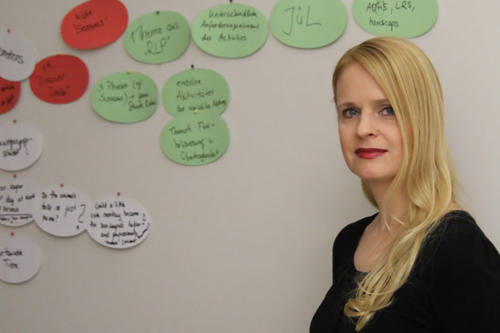Hands Up, and Get That Language Out!
Michaela Sambanis combines foreign language teaching with neurosciences. Movement and emotions play a particularly important role.
Mar 03, 2014
Michaela Sambanis does research where neurosciences and foreign language teaching overlap.
Image Credit: Annika Middeldorf
First the good news: The human brain is omnivorous – “it actually learns incessantly,” says didactics professor Michaela Sambanis. The part of the brain that is constantly on the lookout for new and interesting stimuli is called the hippocampus, also known as the brain’s “novelty detector.” Of the many stimuli to which we are exposed on a constant basis, it filters out only some of them to be linked within the brain.
“Things we find pleasant stand a significantly better chance of being processed further,” Sambanis says. It’s exactly the opposite with negative feelings, such as when we are under too much pressure when learning. “When reproducing what has been learned, the brain recalls the negative emotions associated with the learning process,” Sambanis says – and tends to push them into the background. The result of this evolutionary protective function is that learned content that is associated with negative emotions is harder to recall than positive content.
Good Feelings, Easy Learning
In the same vein, neuroscientists have been able to demonstrate that looking at a photo of a puppy when studying new vocabulary items leads to better learning outcomes than looking at a shark, a comparatively frightening sight. The influence of emotions on learning is a basic phenomenon, however, and is not limited to just language learning.
Sambanis reviews findings from neuroscience to see whether they have practical applications in foreign language instruction. Her big advantage: Sambanis, an expert on didactics, brings together scholarly research with the practical experience she amassed over years of working as a teacher. After writing her professorial thesis (habilitation) in 2006, with more than ten years as a classroom teacher under her belt, Sambanis took on the position of project manager at the Transferzentrum für Neurowissenschaften und Lernen (Transfer Center for Neurosciences and Learning), in the German city of Ulm. Since 2011 she has been a didactics professor at the Institute for English Language and Literature at Freie Universität.
Understanding How the Brain Learns
“I came to the neurosciences purely out of curiosity,” says Sambanis, 43. She wanted to understand how the brain learns and put that knowledge to work in foreign language instruction. In the meantime, she has performed a number of studies on the interface between neuroscience and foreign language teaching. “Translational research” is the name of the area between theory and practice where Sambanis works, both in the classroom and in teaching about findings in the neurosciences.
It often doesn’t take much to link positive feelings with learning content, Sambanis says: Humorously illustrated educational materials alone can have a huge positive impact on memorization – especially among young people who are learning languages. Colorful, fun pictures generate the kinds of good feelings in the brain that cannot be controlled intentionally.
Learning through the Loci Technique
Sambanis says the human brain is actually well suited to learning languages, with their clear rules and recurring patterns. That might sound good from the neuroscientist’s standpoint – but conjugation tables and grammatical rules can often have a dampening effect on those who are trying to learn a language. When this happens, Sambanis recommends that we make use of another of the brain’s preferences: associating things with places, known as the “loci” technique. We use this method unconsciously in our everyday lives, such as when we run through the supermarket in our minds when writing a grocery list or, when looking for a lost key, we return to the place where we last had it.
The same method can also be used to associate verb conjugations, perceived as bothersome, with motions – for example, by touching the head, nose, or ear when a certain verb ending is learned. “Then the brain associates this conjugation with that part of the body. That makes it easier to recall what has been learned later on,” Sambanis says. When we make the motion while stating the verbs at the same time, the brain creates a new node, in a way. The method worked well for Sambanis’s students: Instead of tugging at their hair in desperation, they took to regularly touching an ear, the nose or the shoulder during exams to retrieve the grammatical knowledge “stored” there.
Drama Helps
“I explain to my students how the learning process proceeds in the head, and why we do certain exercises,” Sambanis says. And a little “drama” in her classroom is a welcome addition – at least when exercises in “drama education” are on the agenda. In this process, students participate in activities like miniature theatrical pieces, getting to know a playful and creative way of dealing with the foreign language, for instance by acting out scenes from English literature. “Language consists of more than just the spoken word; it also includes looks, body language, and movement,” says the education expert, whose studies show that learning through movement is especially successful in foreign language instruction.
Movement isn’t just a fundamental physical need in the human body, says Sambanis; it also activates various areas of the brain. “In this situation, language learning can almost happen on the side, and it’s just another tasty morsel for our ever-hungry brain to snap up,” she says.
Further Information
- Univ. Prof. Dr. Michaela Sambanis, Freie Universität Berlin, Institute of English Language and Literature, Tel.: +49 30 838-559 61, Email: sambanis@zedat.fu-berlin.de

